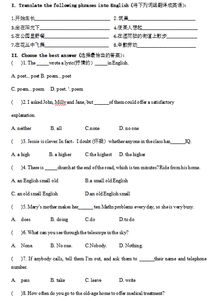牛津七下unit6测试题(苏教版英语7AUnit6习题及答案)
1.苏教版英语7A Unit6习题及答案
译牛7A Unit 6 重点难点讲解我英语不行 看着修能不能帮你1.I don't know what to wear today.我不知道今天该穿什么。
(P90)what to wear是带疑问词的不定式短语,作know的宾语,意为“穿什么”。例如:I don't know what to do next.Could you tell me what to do with the toys?You can go and ask him how to change the film.Do you know how to use it? 你知道这样使用吗?2.I can spend 10 more minutes in bed then.那么我可以在床上多睡十分钟了。
(P90)spend表示花费,可通常用句型spend …on sth / (in ) doing sth.。当spend后跟名词时用介词on,其句型为“spend + 时间/金钱 on sth.”;当spend后跟动词时用介词in,in也可省略,其句型为“spend +时间/ 金钱( in ) doing sth.”。
例如:She doesn't spend enough time on her lessons. 她没有在功课上花足够多的时间。I spend half an hour reading English every day.= I spend half an hour on English every day.我每天花半小时读英语。
How long do you spend on your homework everyday? 你每天花多少时间做作业?10 more minutes意为“再(又)10分钟”,在表示数量的限定词后加more表示“再(又)……”。例如:Can I have two more apples? 我能再要两个苹果吗?I want some more rice.我想再要些米饭。
3.The class 1, Grade 7 students are having a fashion show in the school hall. 七年级一班的学生在学校大厅举行时装表演。(P92)have a fashion show意为“举行时装表演”,have相当于give, hold。
例如:have a talk举行报告会 have a show举行展览We are giving the show to raise money for Project Hope.我们正为希望工程募集资金而举行时装表演。(P93)4. Today we are going to show you the clothes from the 1970s to the 1990s.今天我们打算表演二十世纪七十年代至九十年代的衣服。
(P92)the 1970s读作为the nineteen seventies,意为“二十世纪七十年代”the 1990s 读作为the nineteen nineties,意为“二十世纪九十年代”英语中,在表示整十的年份后加s,且前面用定冠词,则表示“……世纪……年代”。例如:in the 1960s在二十世纪六十年代起5.I'm wearing clothes from the 1990s.我穿着二十世纪九十年代的服装。
(P92)wear意为“穿,戴”。例如:Look! She is wearing a new dress today.她今天穿着一件新连衣裙。
He wears a cotton T-shirt. 他穿着一件棉制的T恤衫。wear, put on与dress都可表示“穿、戴”,但意义有别。
wear强调“穿、戴”的状态,意为“穿着,戴着”;put on强调“穿、戴”的动作,意为“穿上,戴上”。wear与 put on只用作及物动词,后面接表示“衣服”的名词作宾语;dress既可用作及物动词,也可用作不及物动词。
dress作及物动词时接表示“人”的名词作宾语,意为“给……(某人)穿衣服”;作不及物动词时,意为“穿衣服”。例如:Young people all like to wear jeans.年轻人都喜欢穿牛仔裤。
My teacher wears glasses all the year.我的老师一年到头戴着眼镜。It's cold outside. Put on your coat, please. 外面冷,穿上外套吧。
He is not old enough to dress himself.他年龄还小,不会自己穿衣服。Get up and dress quickly. Time to go.快起来穿衣服,该走了。
wear 还可以表示佩带饰物。例如:She always wears a necklace when she goes to the party.她去参加聚会时总是戴项链。
另外,in也可表示“穿着,戴着”的意思,强调“穿、戴”的状态,后面接服饰或颜色一类的词。例如:The young man in a black shirt is from London.穿黑色衬衫的小伙子来自伦敦。
You look so beautiful in green.你穿绿色真漂亮。6.He looks colourful.他看上去很亮丽。
(P92)look可以作连系动词,意为“看上去”,后面接形容词作表语。例如:She looks cool.她看上去很酷。
(P92)Daniel looks smart and modern.(P93)You look so beautiful in a green dress.除了look外,英语中还有一些表示感觉和变化的动词可以作为连系动词。例如:sound, smell(闻起来), taste(尝起来), become, get, feel, turn 等。
例如:I feel so happy today. Mum will buy me a new bike. 我很高兴,妈妈今天要为我买新自行车。Your plan sounds very good. 你的计划听起来不错。
It's getting late. Let's go home .天色不早了,我们回家吧。It turns cold in winter. 冬天天气变冷。
7. She is wearing a black wool skirt, long red leather boots and a red silk blouse.她穿着红色的长筒靴,一件红色的丝绸衬衫。(P93)句中的black和wool同时修饰skirt,long、red及leather同时修饰boots,red和silk同时修饰blouse,注意它们的位置。
英语中,一般把表示性质的形容词放在表示颜色的词前面。当多个形容词修饰同一个名词时,必须遵循一定的顺序。
下面的口诀可以帮助我们记忆:限定描绘大长高,形状年龄和新老,颜色国籍出材料,作用类别往后靠。例如:a round yellow table一张黄色的圆桌a beautiful red French cotton dress一件漂亮的红色法国连衣裙Amy is wearing a yellow silk blouse.爱米穿着一件黄色的丝绸衬衣。
8.What do you think of today's fashion show?你觉得今天的时装表演怎么样?(P。

相关推荐
声明:本网站尊重并保护知识产权,根据《信息网络传播权保护条例》,如果我们转载的作品侵犯了您的权利,请在一个月内通知我们,我们会及时删除。
蜀ICP备2020033479号-4 Copyright © 2016 学习鸟. 页面生成时间:3.018秒









